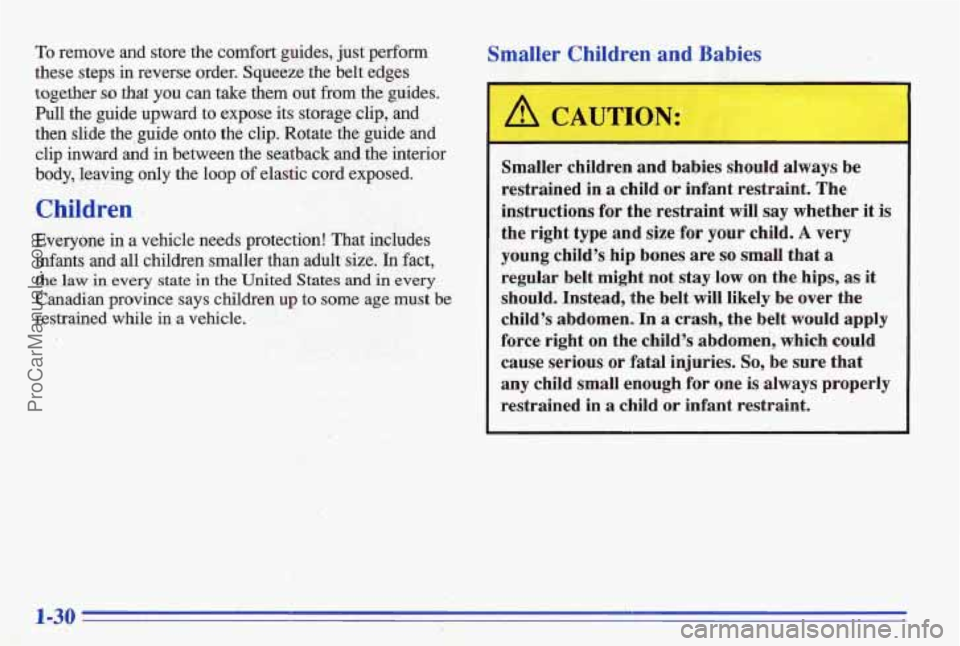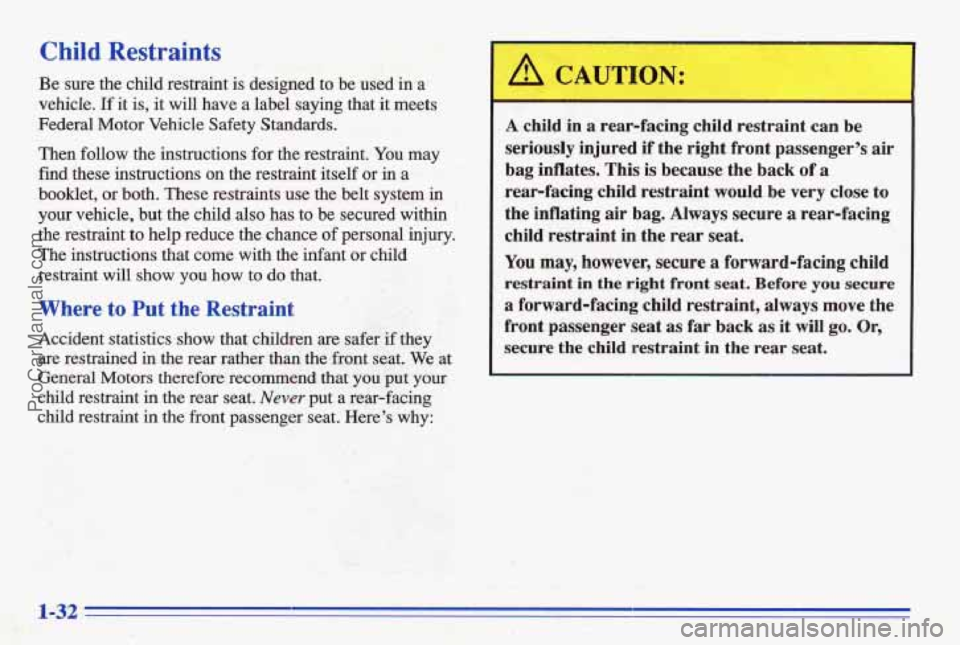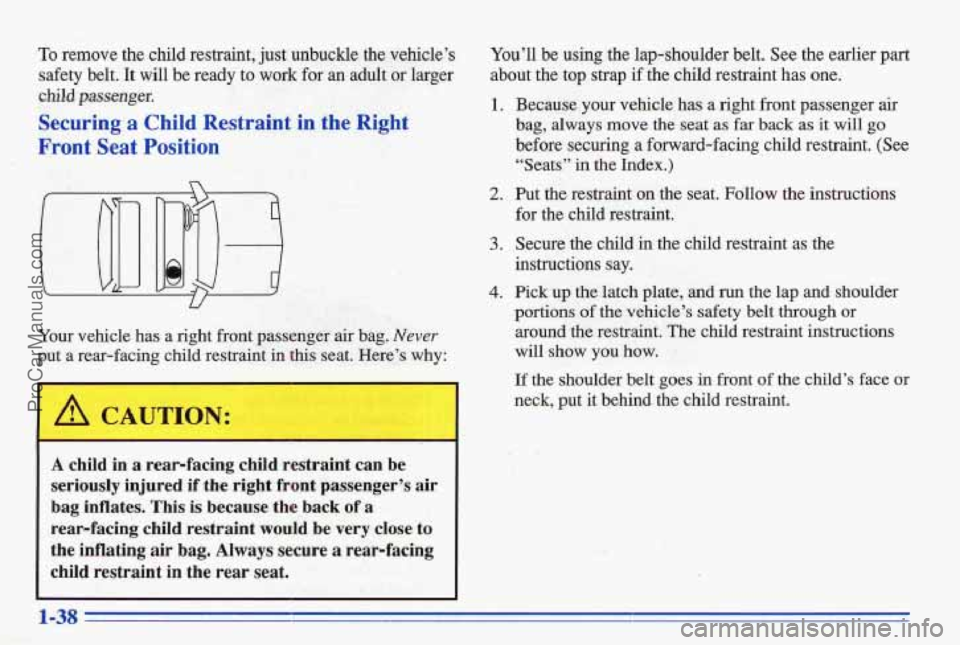Page 34 of 387
I A CAUTION:
You can be seriously hurt if your shoulder belt is
too loose. In a crash, you would move forward
too much, which could increase injury. The
shlder belt should fit against your body.
Rear Safety Belt Comfort Guides for
Children and Small Adults
Rear shoulder belt comfort guides will provide added safety belt comfort for children who have outgrown
child restraints and for small adults. When installed
on a
shoulder belt, the comfort guide pulls the belt away
from the neck and head.
There
is one guide for each outside passenger position in
the rear seat. To provide added safety belt comfort for
children who have outgrown child restraints and for
smaller adults, the comfort guides may be installed
on
the shoulder belts. Here’s how to install a comfort guide
and use the safety belt:
To unlatch the belt, just push the button on the buckle.
1-27
ProCarManuals.com
Page 37 of 387

To remove and store the comfort guides, just perform
these steps
in reverse order. Squeeze the belt edges
together so that.you can take them out from the guides.
Full the guide upward to expose its storage clip, and
then slide the guide onto the clip. Rotate the guide and clip inward id
in between the seatback and the interior
body, leaving only the loop
of elastic cord exposed.
Children
Everyone in a vehicle needs protection! That includes
infants and
all children smaller than adult size. In fact,
the
law in every state in the United States and in every
Canadian province says children
up to some age must be
restrained while
in a vehicle.
Smaller Children- and Babies
A CAUTION:'
Smaller children and babies should always be
restrained in
a child or infant restraint. The
instructions for the restraint will,
say whether it is
the right type and size for your child.
A very
young child's hip bones are
so small that a
regular belt might not stay low om the hips, as it
should. Instead, the belt
will likely be over the
child's abdomen. In
a crash, the belt would apply
force right on the child's abdomen, which could
cause serious or fatal injuries.
So, be sure that
any child small enough for one
is always properly
restrained in
a child or infant restraint.
1-30
ProCarManuals.com
Page 39 of 387

Child Restraints
Be sure the child restraint is designed to be used in a
vehicle. If it is, it will have a label saying that it meets
Federal Motor Vehicle Safety Standards.
Then follow the instructions
for the restraint. You may
find these instructions on the restraint itself or in a
booklet, or both. These restraints use the belt system in
your vehicle, but the child also has to be secured within
the restraint to help reduce the chance of personal injury.
The instructions that come with the infant or child
restraint will show you how to do that.
Where to Put the Restraint
Accident statistics)show that chiIdren are safer if they
are restrained
in the rear rather than the front seat. We at
General Motors therefore recommend that
you put your
child restraint
in the rear seat. Never put a rear-facing
child restraint in the front passenger seat. Here's why:
~ A CAUTION:
A child in a rear-facing child restraint can be
seriously injured if the right front passenger's
air
bag inflates. This is because the back of a
sear-facing child restraint would be very close to
~ the inflating air bag. Always secure a rear-facing
child restraint in the
rear seat.
You may, however, secure a forward-facing child
restraint in the right front seat. Before you secure
a forward-facing child restraint, always move the
front passenger seat
as far back as it will go. Or,
secure the child restraint in the
rear seat.
1-32
ProCarManuals.com
Page 40 of 387
A Top Strap
I A CAUTION:
A child in a child.restraint in the center front seat
can be badly injured by the right frpnt passenger
air bag if it inflates. Never secure a child restraint
in the center front seat.
It's always better to
secure
a child restraint in the rear seat. You may,
however, secure
a forward-facing child restraint
in the right front passenger seat, but only with
the seat moved all the way back.
Wherever
you install it, be sure to secure the c,Md
restraint properly.
Keep in mind that an unsecured child restraint can move
around
in a collision or sudden stop and injure people in
the vehicle. Be sure to properly secure- any child
restraint in your vehicle
-- even when no child is in it. If your child restraint has a top strap, it should be
anchored.
If you need to have an anchor installed, you
can ask your-Pontiac dealer to put it in for you. H.iou
want to install
an anchor yourself, your dealer can tell
you how to do it.
ProCarManuals.com
Page 41 of 387
For cars first sold in Canada, child restraints with a top You'll be using the lap-shoulder b'elt. See the earlier part
strap must be anchored according
to Canadian law. about the top strap if the child restraint has one.
Yam de&r can obtain the hardware kit and instdl it for 1.
you, or you may install it yourself using the htnxctioqs
provided in the
kit.
Use the tether hardware kit available from the dealer.
The hardware and installation instructions were
specifically designed for this vehicle.
2.
3.
Securing a Child Restraint in a Rear
Outside Seat Position
n
u
Put the restraint on the seat Follow the iilstmctions
for the child restraint.
Secure
the child in the child restraint as the
instructions say.
Pick up the latch plate, and
run the lap and shoulder
portions of the vehicle's safety belt through QT
around the restraint. The child restraint instructions
will
show you how.
ProCarManuals.com
Page 43 of 387
6. To tighten the belt, pull up on the shoulder belt while
7. Push and pull the child restraint in different
you push down on the child restraint.
directions to
be sure it is secure.
To remove the child restraint, just unbuckle the vehicle’s
safety belt
and let it go back all the way. The safety belt
will move freely again and be ready to work for an adult
or larger child passenger.
Securing a Child Restraint in the Center
Rear Seat Position
You’ll be using the lap belt.
bA CAUTION:
I
A child in a child restraint in the center front seat
can be badly injured by the right front passenger
air bag
if it inflates. Never secure a child restraint
in the center front seat. It’s always better
to
secure a child restraint in the rear seat. You may,
however, secure a forward-facing child restraint
in the sight front passenger seat, but only with
the seat moved all the way back.
See the earlier part about the top strap if the child
restraint has one.
1-36
ProCarManuals.com
Page 44 of 387
1. Make the belt as long as possible by tilting the latch
plate and pulling it along the belt.
2. Put the restraint on the seat. Follow the instructions
for the child restraint.
3. Secure the child in the child restraint as the
instructions say.
4. Run the vehicle's safety belt through or around the
restraint. The child restraint instructions
will show
you how.
S. Buckle the belt. Make sure the release button is
positioned so you would be able to unbuckle the
safety belt quickly
if you ever had to.
5. To tighten the belt, pull its free end while you push
down on the child restraint.
1. Push and pull the child restraint in different
directions
to be sure it is secure. If it isn't, secure the
restraint in
a different place in the vehicle and
contact the child restraint maker for their advice
about how to attach the child restraint properly.
1-37
ProCarManuals.com
Page 45 of 387

To remove the child restraint, just unbuckle the vehicle’s
safety belt.
It will be ready to work for an adult or larger
child passenger.
Securingta Child Restraint in the Right
Front Seat Position
Your vehicle has a right front passenger air bag. Never
put a.rear-facing child restraint in this seat, Here’s why:
A child in a rear-facing child restraint can be
seriously injured if the right front passenger’s air
bag inflates.
This is because the back of a
rear-facing child restraint would be very clos’e to
the inflating air bag. Always ‘secure a rear-facing
child restraint
in the rear seat.
You’ll be using the lap-shoulder belt. See the earlier part
about the
top strap if the child restraint has one.
1. Because your vehicle has a right front passenger air
bag, always move the seat as far back as it will go
before securing a forward-facing child restraint. (See
“Seats”
in the Index.)
for
the child restraint.
2. Put the restraint on the seat. Follow the instructions
3. Secure the child in the child restraint as the
imtructipns say.
4. Pick up the latch plate, and run the lap and shoulder
portions of the vehicle’s safety
belt through or
around the restraint. The child restraint instructions
will show you how.
If the shoulder belt goes in front of the child’s face or
neck, put
it behind the child restraint.
1 ?Q
ProCarManuals.com